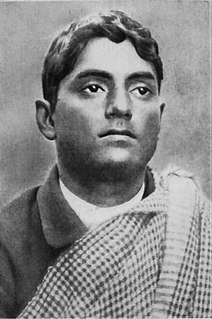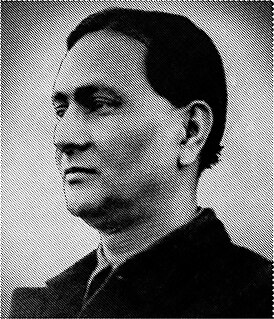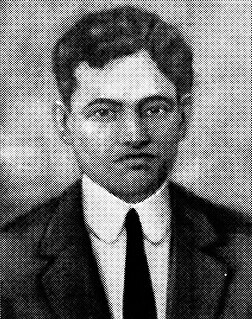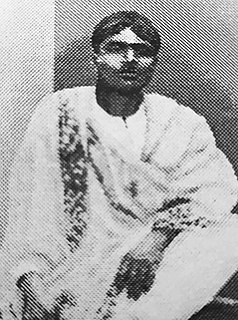
Bagha Jatin or Baghajatin, born Jatindranath Mukherjee, was an Indian independence activist.
Emperor vs Aurobindo Ghosh and others, colloquially referred to as the Alipore Bomb Case, the Muraripukur conspiracy, or the Manicktolla bomb conspiracy, was a criminal case held in India in 1908. The case saw the trial of a number of Indian nationalists of the Anushilan Samiti in Calcutta, under charges of "Waging war against the Government" of the British Raj. The trial was held at Alipore Sessions Court, Calcutta, between May 1908 and May 1909. The trial followed in the wake of the attempt on the life of Presidency Magistrate Douglas Kingsford in Muzaffarpur by Bengali nationalists Khudiram Bose and Prafulla Chaki in April 1908, which was recognised by the Bengal police as linked to attacks against the Raj in the preceding years, including attempts to derail the train carrying Lieutenant-Governor Sir Andrew Fraser in December 1907.

Anushilan Samiti was an Indian fitness club, which was actually used as an underground society for anti-British revolutionaries. In the first quarter of the 20th century it supported revolutionary violence as the means for ending British rule in India. The organisation arose from a conglomeration of local youth groups and gyms (akhara) in Bengal in 1902. It had two prominent, somewhat independent, arms in East and West Bengal, Dhaka Anushilan Samiti, and the Jugantar group.
The Revolutionary movement for Indian Independence was the part of the Indian independence movement comprising the actions of violent underground revolutionary factions. Groups believing in armed revolution against the ruling British fall into this category, as opposed to the generally peaceful civil disobedience movement spearheaded by Mohandas Karamchand Gandhi. The revolutionary groups were mainly concentrated in Bengal, Maharashtra, Bihar, the United Provinces and Punjab. More groups were scattered across India.
Jugantar or Yugantar was one of the two main secret revolutionary trends operating in Bengal for Indian independence. This association, like Anushilan Samiti, started in the guise of suburban fitness club. Several Jugantar members were arrested, hanged, or deported for life to the Cellular Jail in Andaman and many of them joined the Communist Consolidation in the Cellular Jail.

Bipin Behari Ganguly was a member of Indian independence movement and a politician. He was born in Halisahar, Bengal Presidency, on 5 November 1887. His father's name was Akshaynath Ganguly.

Jadu Gopal Mukherjee was a Bengali Indian revolutionary who, as the successor of Jatindranath Mukherjee or Bagha Jatin, led the Jugantar members to recognise and accept Gandhi's movement as the culmination of their own aspiration.

Bhavabhushan Mitra, or Bhaba Bhusan Mitter, alias Swami Satyananda Puri was a Bengali Indian freedom fighter and an influential social worker.

Atulkrishna Ghosh was an Indian revolutionary, member of the Anushilan Samiti, and a leader of the Jugantar movement involved in Hindu German Conspiracy during World War I.
Pandit Mokshada Charan Samadhyayi (1874–?) was a leading figure of the Jugantar movement.

Amarendranath Chatterjee was an Indian independence movement activist. In charge of raising funds for the Jugantar movement, his activities largely covered revolutionary centres in Bihar, Odisha and the United Provinces.
The Ghadar Mutiny (Hindustani: ग़दर राज्य-क्रान्ति, Ġadar Rājya-krānti, Ġadar Baġāvat), also known as the Ghadar Conspiracy, was a plan to initiate a pan-Indian mutiny in the British Indian Army in February 1915 to end the British Raj in India. The plot originated at the onset of World War I, between the Ghadar Party in the United States, the Berlin Committee in Germany, the Indian revolutionary underground in British India and the German Foreign Office through the consulate in San Francisco. The incident derives its name from the North American Ghadar Party, whose members of the Punjabi community in Canada and the United States were among the most prominent participants in the plan. It was the most prominent amongst a number of plans of the much larger Hindu–German Mutiny, formulated between 1914 and 1917 to initiate a Pan-Indian rebellion against the British Raj during World War I. The mutiny was planned to start in the key state of Punjab, followed by mutinies in Bengal and rest of India. Indian units as far as Singapore were planned to participate in the rebellion. The plans were thwarted through a coordinated intelligence and police response. British intelligence infiltrated the Ghadarite movement in Canada and in India, and last-minute intelligence from a spy helped crush the planned uprising in Punjab before it started. Key figures were arrested, and mutinies in smaller units and garrisons within India were also crushed.

Vishnu Ganesh Pingle was an Indian revolutionary and a member of the Ghadar Party who was one of those executed in 1915 following the Lahore conspiracy trial for his role in the Ghadar conspiracy.
The first Christmas Day plot was a conspiracy made by the Indian revolutionary movement in 1909: during the year-ending holidays, the Governor of Bengal organised at his residence a ball in the presence of the Viceroy, the Commander-in-Chief and all the high-ranking officers and officials of the Capital (Calcutta). The 10th Jat Regiment was in charge of the security. Indoctrinated by Jatindranath Mukherjee, its soldiers decided to blow up the ballroom and take advantage of destroying the colonial Government. In keeping with his predecessor Otto von Klemm, a friend of Lokamanya Tilak, on 6 February 1910, M. Arsenyev, the Russian Consul-General, wrote to St Petersburg that it had been intended to "arouse in the country a general perturbation of minds and, thereby, afford the revolutionaries an opportunity to take the power in their hands." According to R. C. Majumdar, "The police had suspected nothing and it is hard to say what the outcome would have been had the soldiers not been betrayed by one of their comrades who informed the authorities about the impending coup".
The history of the Anushilan Samiti stretches from its beginning early in the first decade of 1900 to 1930. The Samiti began in the first decade of the 20th century in Calcutta as conglomeration of local youth groups and gyms. However, its focus was both physical education and proposed moral development of its members. From its inception it sought to promote what it perceived as Indian values and to focus on Indian sports e.g. Lathi and Sword play. It also encouraged its members to study Indian history as well as those of European liberalism including the French Revolution, Russian Nihilism and Italian unification. Soon after its inception it became a radical organisation that sought to end British Raj in India through revolutionary violence. After World War I, it declined steadily as its members identified closely with leftist ideologies and with the Indian National Congress. It briefly rose to prominence in the late second and third decade, being involved in some notable incidences in Calcutta, Chittagong and in the United Provinces. The samiti dissolved before the Second World War into the Revolutionary Socialist Party.
The Howrah-Sibpur Conspiracy case refers to the arrest and trials of 47 Bengali Indian nationalists of the Anushilan Samiti that followed in the wake of the murder of Inspector Shamsul Alam on 24 January 1910 in Calcutta. Alam was Deputy superintendent and intelligence officer in Bengal Police investigating the murder of Naren Gosain, crown-witness in the Alipore bomb case, and other murders including those of Ashutosh Biswas, advocate of Calcutta High Court in charge of prosecution of Gossain murder case, and of Naren Bannerjee, the police officer who arrested Khudiram Bose. Alam had uncovered the underlying Bengali revolutionary network of the Anushilan Samiti that linked the murders and other robberies in this time, and at the time of his own murder in the hands of Biren Dutta Gupta, Alam was preparing to consolidate the charges to bring them all to trial in a single case.
Srish Pal was a Bengali revolutionary, born in Mulbarga, Dacca, British India. His full name was Shrish Chandra Pal. He was attracted to revolutionary politics in 1905 with the guidance of Hemchandra Ghosh. He joined the Dhaka-based Mukti Sangha. Pal was a follower of Netaji Subhas Chandra Bose.
Manindra Nath Nayak was a Bengali revolutionary and Indian independence activist.

Srish Chandra Mitra or Habu was a Bengali revolutionary and active member of Indian independence movement.
Haridas Dutta was a Bengali revolutionary involved with Rodda company arms heist case.







